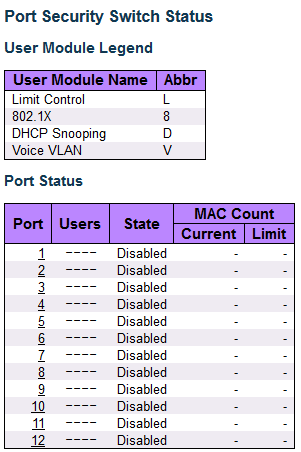Network -- Port Security -- Switch Status
This page shows the Port Security status, which is a module with no direct configuration. Configuration comes indirectly from other modules—the user modules. When a user module has enabled port security on a port, the port is set up for software-based learning. In this mode, frames from unknown MAC addresses are passed on to the port security module, which in turn asks all user modules whether to allow this new MAC address to forward or block it.
For a MAC address to be set in the forwarding state, all enabled user modules must unanimously agree on allowing the MAC address to forward. If only one chooses to block it, it will be blocked until that user module decides otherwise.
The status page is divided into two sections: one with a legend of user modules, and one with the actual port status.

| Object | Description |
|---|---|
| User Module Legend | |
| User Module Name | The full name of a module that may request Port Security services. |
| Abbr | A one-letter abbreviation of the user module. This is used in the Users column in the port status table. |
| Port Status | |
| Port | The port number for which the status applies. Click the port number to see the status for this particular port. |
| Users | Each of the user modules has a column that shows whether that module has enabled Port Security or not. A '-' means that the corresponding user module is not enabled, whereas a letter indicates that the user module abbreviated by that letter (see Abbr) has enabled port security. |
| State | Shows the current state of the port. It can take one
of four values:
|
| MAC Count (Current, Limit) | The two columns indicate the number of currently
learned MAC addresses (forwarding as well as blocked) and the maximum number
of MAC addresses that can be learned on the port, respectively.
If no user
modules are enabled on the port, the Current column will show a dash (-). If the Limit Control user module is not enabled on the port, the Limit column will show a dash (-). |
| Buttons | |
|---|---|
 |
Refresh the page automatically every three seconds. |
 |
Refresh the page immediately. Any non-committed changes will be lost. |

